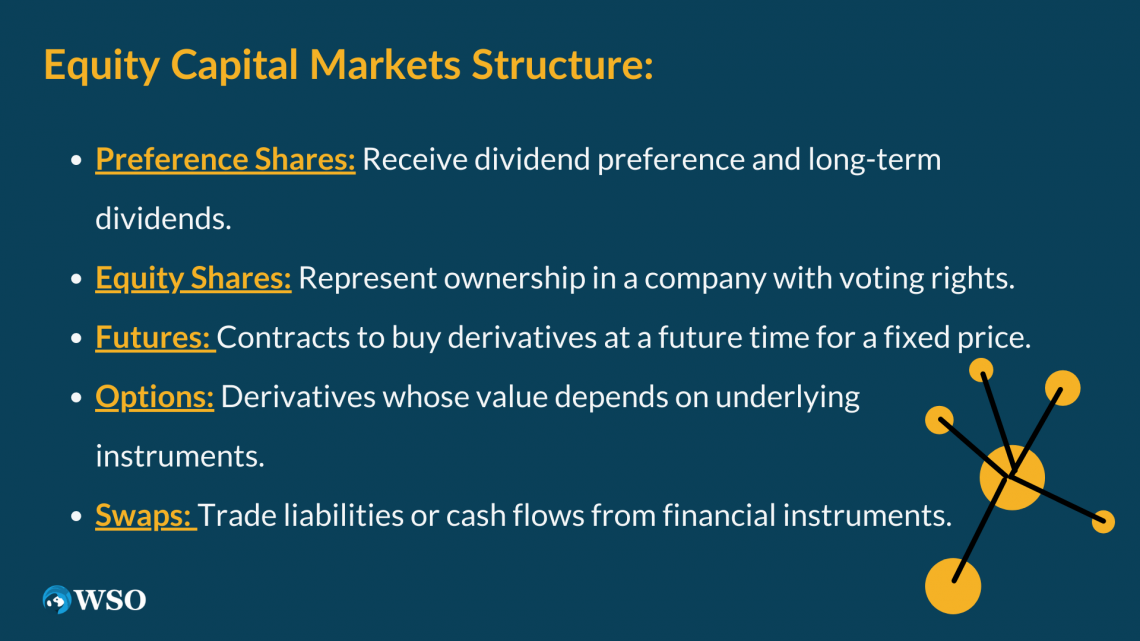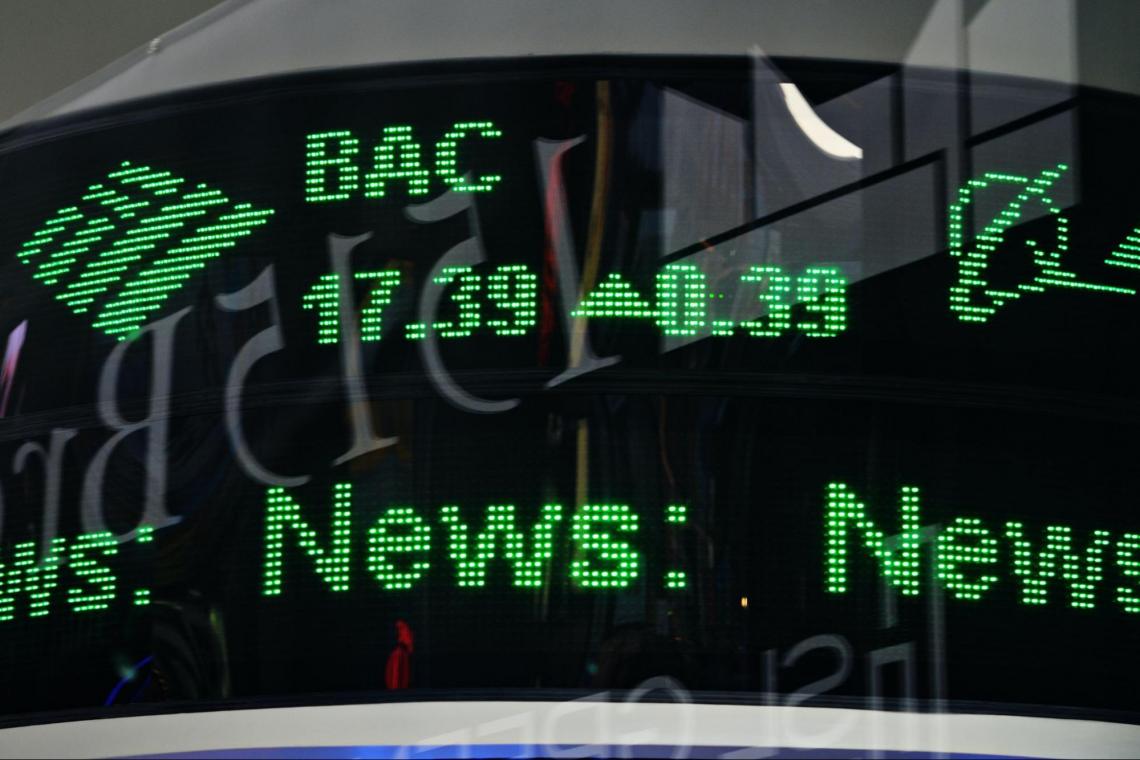Equity Capital Market (ECM)
Where financial institutions and potential businesses try to raise financing.
An equity capital market, or ECM, is where financial institutions and potential businesses try to raise financing. Equity capital markets are segmented into specialized niches since each institution has unique requirements.

The most reliable platforms for IPOs are equity capital markets.
Equity Capital Markets and Debt Capital Markets are closely related and fall under the same category of investment banking. In addition, banks frequently have the ECM and DCM groups in the same division since they collaborate at a similar level.
ECMs lose some of their sheens during uncertain periods like market crashes, bank failures, liquidation problems, bankruptcy, and the 2020 pandemic. However, this market naturally corrects itself over time, depending on the severity of the harm.
An initial public offering (IPO) is the first time a privately held firm sells shares to the general public, making it a publicly traded company on the equity markets.
It creates a foundation of liquidity that can be used for debt repayment, mergers, acquisitions, and removing working capital constraints.
In the equity capital markets, your days are either spent making business proposals or carrying out current mandates.

ECM groups, like other capital markets teams at banks, can be compared to a hybrid of sales and trading and investment banking.
The equity market brings buyers and sellers with similar pricing expectations together. Companies enter the corporate sector as private players once they have established themselves.
Then, they conduct an Initial Public Offering to issue shares (IPO). This opens up access to their assets to retail investors who monitor the stock markets for the day's finest stock offers.
If you belong to this group, major time will be spent advising businesses looking to raise equity financing.
In contrast to raising debt, where the company maintains its own but is required to pay interest on the funds it grows, "raising equity capital" refers to selling a portion of the company's ownership in exchange for cash.
What is the definition of Equity Capital Markets?
Since ECMs contain numerous divisions, such as bond markets, book-building, and private placements, they are always larger than stock markets.

They are essential to the economy because a country's equity markets serve as a vital barometer of the overall economy's health.
Reputable firms frequently turn to large financial institutions like investment banks, including renowned organizations like Goldman Sachs, Morgan Stanley, JP Morgan, Citi Bank, etc., if they need a sizable quantity of equity injection to reach a greater growth rate.
As a result, areas of expertise might be found in energy, the environment, or even governmental organizations. However, other organizations' coverage is broader and lacks a specific focus.
However, some businesses or banks have various divisions that each have a distinct focus while still being under the general umbrella of the investment banking branch.
With the assistance of junior-level analysts and associates, mid-level employees concentrate on execution, while upper-level executives spend more time on origination.

ECM itself has several responsibilities. Like in debt capital markets, a few people might be working on the syndication aspect.
The Equities Capital Markets team assists in executing and syndicating such issuances and provides customers with advice on issuing equity or equity-linked instruments. Initial Public Offerings (IPOs), Follow-On Offerings (FPOs), Private Placements, Convertible Bonds, and other mechanisms can be used to issue equity.
What is the structure of the Equity Capital Markets?
Within the equity markets, there are two markets: the primary market and the secondary market. In addition, various instruments are traded in the equity capital markets.

A few of them have been mentioned below:
1. Preference Shares
Regarding dividend payments, preference shares are those that receive preference over other equity shares.
Preference shareholders own preference shares and are the first to receive payouts if the business decides to distribute dividends to its shareholders.
As a result, another approach to describe preference stock is as an investment whose holders have the right to receive dividends for the duration of the firm.
2. Equity Shares
Common stocks are financial instruments that represent an investor's ownership of a business. Once you own common stock in a firm, you can vote and elect the board of directors for that company.
Thanks to these voting rights, you can participate in internal corporate decision-making and vote on various corporate policies.
3. Futures
A futures contract is one of these financial instruments where a buyer (the one with the long position) and the seller (the one with the short position) enter into a contract or agreement, and the buyer commits to buy a derivative or index at a specific future time for a fixed price.
4. Options
Options are a kind of derivative; hence the value of an underlying instrument determines the value of an option.
A stock is one type of underlying instrument, but others include an index, a currency, a commodity, or any other kind of security.
5. Swaps
When two parties agree to trade liabilities or cash flows from various financial instruments, the agreement is known as a swap derivative.
Swap trading sometimes relies on loans or bonds, also referred to as a notional principal amount.
Primary Markets
This is where businesses first introduce or issue their stock market shares, also known as the issue market. Then, corporations can publicly distribute their shares in an IPO or a follow-on public offering (FPO).

They may also consider rights issues, which would permit their current owners to keep the same percentage of the shares they owned initially and sell them at a discount to the current market price.
For its long-term financing needs, a corporation turns to the primary market. Therefore, one characteristic of the leading market is that it can meet the demand for long-term capital.
In the primary market, new securities are released. Retail and institutional investors often make up the buyers. The primary public market and the private placement market are two distinct sections of the primary market.
1. Private Placement Market:
This is the path that companies take to raise capital or equity via private unquoted shares, which are directly sold to investors.
2. Primary Public Markets:
Through IPOs, private companies go public; listed corporations can issue more securities to raise new equity.

A company chooses to raise its Initial Public Offering (IPO) in the primary market to become publicly traded for the first time. A primary market is also referred to as the New Issue Market (NIM) because securities are sold here for the first time.
In the primary market, the company offers its shares directly to investors during an IPO. Underwriting is the full process of generating investment cash by offering new stock to investors through an IPO.
Traders on the secondary market buy and sell shares after they have been sold.
Functions and Advantages of Primary Markets
The primary market is a capital market section where organizations like businesses, governments, and other institutions raise money by selling debt- and equity-based instruments.

Let us look at some of the functions and advantages of primary markets.
Functions
1. Underwriting Services
Underwriting is one of the most crucial and significant components of making a new issue offer. In the primary market, an underwriter's job is to purchase unsold shares. Financial institutions frequently act as underwriters and profit from the process through commissions.
2. New Issue Offer
Issuing a new offer involves several steps. First, it entails a thorough evaluation of a project's viability. Among the financial arrangements used for the task are the promoter's debt-to-equity ratio, liquidity ratio, and equity ratio, among others.
Companies can raise capital for a reasonable price, and the securities issued in the primary market have high liquidity since they may be quickly sold in the secondary market.

Primary markets play a crucial role in an economy's ability to mobilize savings. Here are some other advantages associated with the primary markets:
Advantages
- Businesses can easily and affordably raise cash for their operations in a primary market. Additionally, the secondary market offers practically immediate access to assets traded in the main market, resulting in significant liquidity.
- The likelihood of price manipulation in the main market is lower than in the secondary market. Better operations and transparency result from this.
- Investors can diversify their portfolios through the primary market, reducing their risk exposure.
Secondary Markets
The secondary market is where securities are considered to enter once they have been offered for sale for the second time and are transferred from one investor to another.

This market category includes trading securities from semi-government entities, governmental organizations, joint-stock enterprises, etc. It is intended for investors that participate in day trading.
The secondary market resembles the stock market more closely. Similar transactions occur with shares, stock trades by dealers, and over-the-counter (OTC) marketplaces.
In the secondary market, securities that investors already possess are bought and sold. Finally, the primary market, which equities are also sold on when they are first issued, is what most people consider "the stock market."
Stocks are one of the most widely traded securities, but there are other secondary markets. For example, bonds and mutual funds are bought and sold on secondary markets by businesses, individuals, and investment banks.

Transactions in the secondary market are advantageous for all kinds of investors. Due to the enormous volume of transactions, their costs have been drastically decreased.
Some examples of secondary markets are NASDAQ and the London Stock Exchange. Because the transactions take place after the Initial Public Offer, it is also known as a follow-on public offering.
Types of Secondary Markets
The area where securities are traded after leaving the original issuer is known as the secondary market. The securities could be stock shares, ETFs, or close-ended funds, which are frequently exchanged.
1. Over-the-counter market
In these decentralized markets, investors trade among themselves. In these markets, vendors charge different prices from one another due to the intense competition for bigger volume sales.
The transaction's one-to-one nature makes the risk higher than it would be with an exchange. OTC marketplaces contain things like foreign exchange.
In the case of the over-the-counter market, the use case is the same. But the absence of regulation is the issue.
Investors transact with one another on the secondary market, called a stock exchange. Stock exchanges are strictly controlled to eliminate any possibility of fraud.

Because it is a safe and secure choice for everyone dealing in the secondary market, we, as investors, can rely on these exchanges.
In this kind of secondary market, there is no direct interaction between the seller and the buyer of securities. Regulations have been put in place to guarantee the safety of trading.
Since the exchange is a guarantor, there is essentially no counterparty risk.
Investors trade in secondary markets instead of doing business with issuers straight up. When you deal on a secondary market, the asset has already been issued on a primary market when the transaction occurs.
As another security frequently traded on the secondary market, the mortgage market is a valuable illustration of the secondary market. Consumer mortgages are written by financial institutions, a type of mortgage security.
Functions and Advantages of Secondary Markets
The equity capital market forces companies to give investors ownership in exchange for money. As a result, the former benefits financially, and the latter has ownership rights.

In addition, the stock market aids in boosting liquidity and investment opportunities, which all contribute to a stronger economy.
Let's have a look at the functions and advantages of secondary markets.
Functions
- With the help of demand and supply in the market, the secondary market attains an equilibrium point (the point where demand matches supply), leading to the fair value of stocks.
- Secondary markets aid capital distribution by alerting investors to the values of the shares that still need to be released from the primary market to the secondary market.
- A secondary market acts as a platform for determining the price at which assets should be sold based on supply and demand.
- Investors can easily sell shares on a controlled marketplace. On several stock exchanges, they can sell the securities they possess.
- The secondary market aids investors in selecting shares for purchase and sale, which promotes the development of a strong portfolio.

Secondary markets help investors and traders in several ways. But first, let us see some of the advantages associated with transacting in the secondary markets:
Advantages
- Investors can liquidate their holdings by selling them on the secondary market.
- In a secondary market, price changes for securities occur quickly in response to the availability of new corporate information.
- The secondary market is controlled to eliminate any possibility of fraud and to safeguard investors' money.
- Savings can be more easily accessed when they are held in securities by investors.
- Due to the stringent regulations controlling a secondary stock market, investors' funds stay comparatively safer.
The Bottom Line
Under the same investment banking umbrella as equity capital markets (ECM), DCM collaborates closely with ECM. Banks frequently position the ECM and DCM groups under the same division.

You should look for an ECM organization if you have a business that needs to raise money, conduct an IPO, or seek investors.
You'll be prepared to discover a means to get the money you need or go public through an ECM group, whether it's a specific company or division within a larger investment bank. However, not all businesses run or raise capital in the same manner.
ECM experts can assist with transaction structuring, deal hunting, or presentation preparation for prospective clients. Analysts, strategists, and executives are among the several ECM employees.
Meanwhile, one-on-one investing operates as it would with a single person. But this would depend on whether the business was raising equity or going public.




or Want to Sign up with your social account?